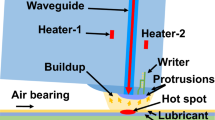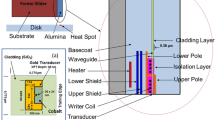Abstract
To increase the storage density of hard disk drives, the flying height of the slider needs to be reduced to <10 nm. This requires super-smooth surfaces of the disk and slider. As the roughness decreases, stiction and adhesion are found to increase substantially leading to failures of the head/disk interface. Texturing the slider surface is a well-known approach to this issue. In this study we investigated laser ablation as a potential process for texturing magnetic recording sliders. It was found that straight laser machining caused unwanted re-deposition of material. These deposits could be significantly reduced by using a chemical etching enhanced laser process.
Similar content being viewed by others
Avoid common mistakes on your manuscript.
1 Introduction
In present day hard disk drives, the maximum storage density is in the order of 150 Gbits/inch2. In order to increase the recording density to approximately 1 Tbit/inch2, a reduction in flying height from currently 10 nm to 3 nm is required. A flying height of 3 nm requires that the surface of the disk is very “smooth”, with a peak-to-valley roughness in the order of <1 nm. As the roughness of the disk is decreased, stiction and adhesion are found to increase substantially during contacts between slider and disk. Contacts between a “super-smooth” head and disk are undesirable since the increased adhesion resulting from contact between smooth surfaces can lead to failure of the head/disk interface.
2 Texturing of surfaces to reduce friction
It is well known that stiction and adhesion of the head/disk interface can be reduced by texturing the surface of the slider (Lee 2004). The variation of the friction coefficient as a function of texture height is shown in Fig. 1.
Friction coefficient depending on the texture height of the slider (Zhou 2002)
Mechanical texturing, reactive ion beam etching, RF magnetron sputtering, or laser ablation have been used for texturing surfaces (Etsion 2005). Texturing by reactive ion beam etching and RF magnetron sputtering yields a bimodal distribution of the surface roughness, since the alumina in the slider material (alumina/TiC) is etched at a higher rate than the TiC (Zhou 2002) (Fig. 2).
Island-type texture created by ion beam etching (Zhou 2002)
The use of reactive ion beam etching for texturing sliders require masking of the read/write element to prevent damage of the magnetoresistive read element in the head. Masking is cumbersome and time-consuming, and leaves a step increase in the surface height of the slider in the area, where the read/write head was masked. Thus, the question arises whether other manufacturing methods would be available for texturing of sliders with high throughput and without the need for masking the read/write element.
This paper is directed toward the study of laser ablation as a potential process for texturing magnetic recording sliders. We first investigate the feasibility of laser ablation of Al2O3TiC and then explore methods to vary the depth and surface characteristics of textured surfaces. Finally, we investigate the effect of power variation and partial laser light absorption to control the height of the surface texture achievable.
3 Experimental procedure
A schematic of the experimental setup is shown in Fig. 3. Test samples of Al2O3TiC were exposed with an ArF-Excimer laser with 193 nm wave length and 20 ns pulse width. The laser beam was defined for a square area of 3.6 mm × 3.6 mm and was projected with a magnification of 1/12 onto the test sample.
3.1 Laser ablation with decreasing laser power density
In the first set of experiments, the power of the laser beam was kept constant. After completion of a test, the power of the beam was decreased and a new sample was exposed.
The highest energy density used was 2,300 mJ/cm². The reduction of the energy density was accomplished by the use of attenuator plates as summarized in Table 1.
3.2 Chemical etching enhanced laser ablation
In the second set of experiments, laser ablation was assisted by a wet chemical etching process (Mora 2005). A schematic of this setup is shown in Fig. 4. For this application silicon shows a similar behavior in terms of the achieved surface structure as Al2O3TiC (von Gutfeld and Hodgson 1982; von Gutfeld and Sheppard 1998). For this reason and because of easier preparation, silicon samples were tested. The samples were placed in a container filled with an aqueous solution. The height of the solution over the sample was chosen so that the sample was 1 mm below the surface of the liquid.
Water with various concentrations of acid was tested. The attenuation of the laser beam was found to be about 70%, resulting in an energy density of 700 mJ/cm2.
4 Results
The RMS roughness of Al2O3TiC samples used for setting (Sect. 3.1) was 2.9 nmFootnote 1 before texturing. From AFM scans of laser ablated surfaces without attenuator plates, we observed that the surface roughness after texturing was in the order of 45 nm RMS. Material (mostly alumina) was removed from the alumina/TiC samples, where it was exposed to the laser beam. Part of the removed material was re-deposited in the areas, where it had been removed. Surface roughness measurements of the surfaces showed that the highest peaks after texturing were higher than the highest peaks prior to texturing, i.e., laser ablation with high power levels increased the roughness of the surface by the re-deposition of material removed during ablation as shown in Figs. 5, 6, and 7. This “additive” process is different from reactive ion etching, where material is only removed but not added at the same time.
To change the height distribution of the laser ablated surface, we decreased the power level of the laser using attenuator plates. However, even in this case build-up of surface asperities was found to occur even at very low power levels as shown in Fig. 8.
Since the re-deposition of ablated material is undesirable, etching enhanced laser ablation in water and ethanol was performed next (Fig. 9). Since the effect of re-deposition is well known for silicon (von Gutfeld and Sheppard 1998), we examined the texturing of silicon samples.
A typical textured surface obtained with this process is shown in Figs. 10 and 11. Figure 10 shows the surface roughness image using white light interferometry, and Fig. 11 shows the surface roughness using AFM analysis. We observe that re-deposition of material is strongly reduced compared to pure laser ablation. However, even in this case, re-deposition of some ablated material is found to occur on the sample surface (Fig. 10), as can be observed from surface roughness traces over the textured surface. Figure 11a shows the surface roughness using an AFM, and Fig. 11b shows the roughness trace along the upper and lower straight lines of Fig. 11a. We observe that the peak-to-valley roughness is in the order of 20 nm, with an RMS value of 1.59.
5 Summary
Texturing of alumina/TiC and silicon samples using laser ablation and liquid assisted laser ablation was performed in this study. Straight laser ablation was found to result in textured alumina/TiC with high peak-to-peak surface roughness and a high amount of build-up of deposits, depending on power and number of the laser pulses. Chemical enhanced laser etching was found to result in textured silicon surfaces with reduced peak-to-peak roughness and significantly reduced deposits of laser ablated material. These results for silicon encourage the study of chemical enhanced laser etching for alumina/TiC which is a common material for magnetic recording sliders.
It is likely that the use of lasers with shorter-pulse length will further reduce the deposition of unwanted material and thus yield improved textured surfaces.
Notes
RMS roughness of common sliders: 0.1 nm or less.
References
Etsion I (2005) State of the art in laser surface texturing. J Tribol 127:148–153
Lee SC (2004) Strategies to avoid head-disk instabilities due to adhesion in ultra-low flying head-disk interfaces. IEEE Trans Magn 40:3130–3135. doi:10.1109/TMAG.2004.828972
Mora A (2005) A discrete model for laser driven etching and microstructuring of metallic surfaces. Phys Rev E Stat Nonlin Soft Matter Phys 72(6 Pt 1):061604. doi:10.1103/PhysRevE.72.061604
von Gutfeld RJ, Hodgson RT (1982) Laser enhanced etching in KOH. Appl Phys Lett 40:352–354. doi:10.1063/1.93069
von Gutfeld RJ, Sheppard KG (1998) Electrochemical microfabrication by laser-enhanced photothermal processes. IBM J Res Develop 42(5):639
Zhou L (2002) Tribology of Textured Sliders in Near Contact Situations. IEEE Trans Magn 38:2159–2161. doi:10.1109/TMAG.2002.802797
Acknowledgment
This research was supported in part by a grant from the Bavaria Technology Center, Germany.
Open Access
This article is distributed under the terms of the Creative Commons Attribution Noncommercial License which permits any noncommercial use, distribution, and reproduction in any medium, provided the original author(s) and source are credited.
Author information
Authors and Affiliations
Corresponding author
Rights and permissions
Open Access This is an open access article distributed under the terms of the Creative Commons Attribution Noncommercial License (https://creativecommons.org/licenses/by-nc/2.0), which permits any noncommercial use, distribution, and reproduction in any medium, provided the original author(s) and source are credited.
About this article
Cite this article
Hausmann, U.P., Joerges, P., Heinzl, J. et al. Nano-texturing of magnetic recording sliders via laser ablation. Microsyst Technol 15, 1747–1751 (2009). https://doi.org/10.1007/s00542-009-0890-6
Received:
Accepted:
Published:
Issue Date:
DOI: https://doi.org/10.1007/s00542-009-0890-6















